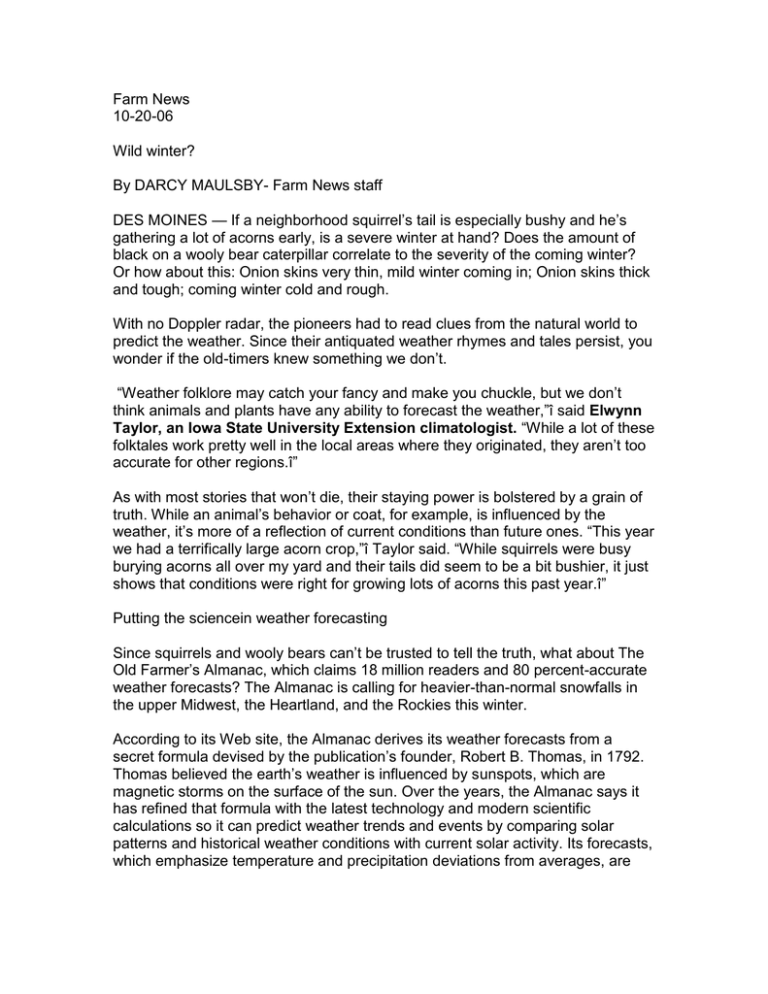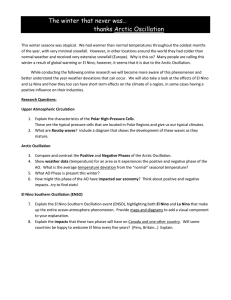Farm News 10-20-06 Wild winter?
advertisement

Farm News 10-20-06 Wild winter? By DARCY MAULSBY- Farm News staff DES MOINES — If a neighborhood squirrel’s tail is especially bushy and he’s gathering a lot of acorns early, is a severe winter at hand? Does the amount of black on a wooly bear caterpillar correlate to the severity of the coming winter? Or how about this: Onion skins very thin, mild winter coming in; Onion skins thick and tough; coming winter cold and rough. With no Doppler radar, the pioneers had to read clues from the natural world to predict the weather. Since their antiquated weather rhymes and tales persist, you wonder if the old-timers knew something we don’t. “Weather folklore may catch your fancy and make you chuckle, but we don’t think animals and plants have any ability to forecast the weather,”î said Elwynn Taylor, an Iowa State University Extension climatologist. “While a lot of these folktales work pretty well in the local areas where they originated, they aren’t too accurate for other regions.î” As with most stories that won’t die, their staying power is bolstered by a grain of truth. While an animal’s behavior or coat, for example, is influenced by the weather, it’s more of a reflection of current conditions than future ones. “This year we had a terrifically large acorn crop,”î Taylor said. “While squirrels were busy burying acorns all over my yard and their tails did seem to be a bit bushier, it just shows that conditions were right for growing lots of acorns this past year.î” Putting the sciencein weather forecasting Since squirrels and wooly bears can’t be trusted to tell the truth, what about The Old Farmer’s Almanac, which claims 18 million readers and 80 percent-accurate weather forecasts? The Almanac is calling for heavier-than-normal snowfalls in the upper Midwest, the Heartland, and the Rockies this winter. According to its Web site, the Almanac derives its weather forecasts from a secret formula devised by the publication’s founder, Robert B. Thomas, in 1792. Thomas believed the earth’s weather is influenced by sunspots, which are magnetic storms on the surface of the sun. Over the years, the Almanac says it has refined that formula with the latest technology and modern scientific calculations so it can predict weather trends and events by comparing solar patterns and historical weather conditions with current solar activity. Its forecasts, which emphasize temperature and precipitation deviations from averages, are based on 30-year statistical averages prepared by government meteorological agencies. While the Almanac has offered its yearly predictions for generations, the National Weather Service has relied on its version of scientific weather forecasting for more than a century. In 1870, President Ulysses S. Grant signed a joint resolution of Congress authorizing the Secretary of War to establish a national weather service. After operating under the War Department from 1870 to 1891 and becoming part of the U.S. Department of Agriculture from 1891-1940, the Weather Bureau (now called the National Weather Service) was transferred by President Franklin D. Roosevelt to the Department of Commerce, where it remains today. In recent years, new technology has improved the accuracy of the weather service’s short-term forecasts. “Today the 48-hour forecast is about as accurate as the 24-hour forecast used to be,î” said Harry Hillaker, Iowa’s state climatologist. “The skill on forecasts for 30 days and beyond hasn’t improved in 30 years, though. That may explain why weather folklore is still around.”î Will El Nino determine our winter weather? While bushy-tailed squirrels and wooly bears might be closer to home, the oscillation of the ocean-atmosphere systems in the Pacific Ocean has proven to be a much more reliable predictor of Iowa’s winter weather. “The Pacific Ocean is such a huge part of the earth’s surface that it influences weather over a wide area,î” Taylor said. “Starting in the late 1970s and early 1980s, an improved understanding of El Nino and La Nina has been one of the most valuable tools in climatology.î” The current El Nino started at the end of this summer and is expected to last through the spring of 2007. El Nino conditions tend to bring fall weather that’s a little cooler and wetter than normal, as well as a little snowier than normal in October/November and later again in the spring. The total winter snowfall, however, tends to be about average. “Just when you think winter’s really going to set in, the mid-winter from January through February usually ends up warmer and drier,î” Hillaker said. “Then when the temperatures hit the 50s and 60s in February and you think spring is just around the corner, the cold and snow return.î” While an El Nino doesn’t mean Iowa won’t have some really cold winter days ahead, it indicates the state probably won’t have a bitterly cold winter overall, Taylor added. While this holds true about 85 percent of the time, there are variables that can create the opposite effect. While a strong El Nino event occurred during 19111912, for example, Iowa experienced a very cold, snowy winter. “The state record of 47 degrees below zero was set in 1912,”î said Hillaker, who noted that the last strong El Nino occurred in 1997-98. “Those weather conditions also explain why the icebergs that sank the Titanic were farther south than normal in the spring of 1912.î” While El Ninos also tend to foster cooler, wetter springs, could drier days lie ahead? “Things can change drastically right after an El Nino ends,î” said Taylor, who noted that Iowa is due for a drought in the next few years. “There was an El Nino going on in 1983, which ended up a drought year, and again in 1987 before the big drought of 1988.î”







